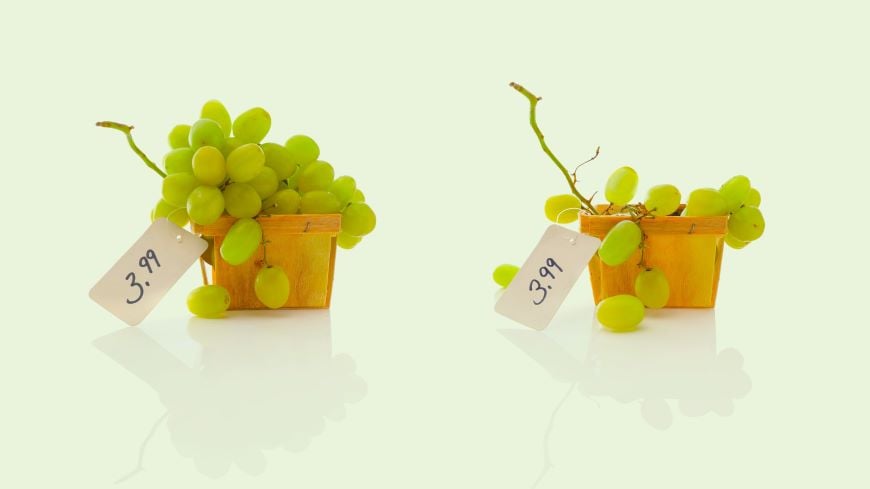This website uses cookies so that we can provide you with the best user experience possible. Cookie information is stored in your browser and performs functions such as recognising you when you return to our website and helping our team to understand which sections of the website you find most interesting and useful.
The Masked Price: how shrinkflation hurts consumer choice

Shrinking sizes for the same price masks real cost rises, leaving consumers in the dark about what is best value. In times of such high inflation this practice has to stop.
What is shrinkflation?
High food inflation is here and consumers are paying in more ways than one. They may be used to painful price hikes for grocery essentials but may not have spotted a more insidious hit on their wallet due to “shrinkflation”.
‘Shrinkflation’ describes the stealthy practice of brands quietly reducing the size of their products without reducing the price. Examples have been around for some time but are now becoming commonplace as brands look for ways to reduce the impact of spiraling inflation on their bottom line.
Where do we find shrinkflation?
Our members have been tracking the phenomena. In Portugal, a Deco Proteste survey tracked pack size and price from March 2022 to November 2022 and found: non-dairy spreads that had been reduced by 50g on sale at the same or higher price, meaning a real time increase of 31% in some supermarkets. They also spotted chocolate milk powder containing 10g less on sale at the same or higher price after 8 months leaving customers of some supermarkets with a massive 47% increase.
In Spain, OCU found that 7% products in a typical grocery basket had been shrunk whilst maintaining or raising their price including: yogurts with 5g less per tub, one euro sausage packs with increasingly fewer slices, and margarine, pasta or cocoa powder which look the same as usual but have less contents.
Consumer groups across the world including CHOICE in Australia have also found this was common practice amongst many popular supermarket brands of pet food, cereals and chocolate.
Masking true price makes informed choices impossible
Without spot checks or more comprehensive monitoring of pricing, this is a practice that is very difficult for individual consumers to check on. It would require fastidiously checking the unit price on every item and comparing it with the price, weight and quantity on sale previously and figuring out what the actual difference in price is – not something a busy shopper has time for.
Information remedies like unit pricing are only part of the answer. Consumer protection laws generally require retailers to display unit prices which help shoppers see the true price per unit weight and compare products more easily. However there are no requirements to show what the unit price was before a price change.
The masking of prices in this way makes it very hard for consumers to make an informed choice about the best value product for them. And the marketers will be well aware of the consumer cognitive biases that mean reductions in pack sizes are more attractive than rises in price – even if a price rise may mean better value overall.
But is Shrinkflation illegal?
When shrinkflation occurs, consumers are not notified that they have experienced a price rise. Or, if they have the manufacturer is able to make a price rise appear smaller than it actually is.
This is not technically seen as fraudulent if the information on the product label and price tag is correct – in principle the packaging and labeling complies with regulations.
However, the practice does translate into a price increase that may go unnoticed and is likely to mislead consumers. This type of manipulation of choice is increasingly being couched as a deceptive practice which has an impact on competition.
This is the basis on which OCU has brought a complaint to the Spanish competition authority, the CNMC.
“OCU considers shrinkflation to be a practice of unfair competition, since there is no complete and clear information for the consumer about the price increase and that lack of transparency alters competition.”
OCU has denounced the six companies in which it has so far detected this practice, Pastas Gallo, Danone, Pescanova, Colacao, Tulipán and Campofrío but hasn’t ruled out adding more products and companies.”
Similar complaints have been filed with authorities including Italy where Altroconsumo’s consumer panel reported many examples of shrinking products. There, both the Antitrust authority received a complaint on the grounds of an unfair trading practice and the public prosecutor’s office on the grounds of whether this practice might actually constitute an offence.
Time for an EU-wide approach on shrinkflation?
European Justice and Consumer Commissioner Didier Reyner was recently asked about the shrinkflation and whether it was considered a suspect or misleading practice.
He reiterated that the EU Unfair Commercial Practices Directive prohibits various types of traders’ misleading commercial practices that cause or are likely to cause the average consumer to take a transactional decision that they would not have taken otherwise.
He encouraged consumers to report such practices to their national authorities on the grounds that “shrinkflation practices could consist of a misleading overall presentation of the product in a way that deceives or is likely to deceive the average consumer about the product’s size.”
Consumer protection organizations are committed to detecting incidents of shrinkflation practices. It is crucial that authorities quickly get to grips with shrinkflation practices. This is a particularly duplicitous way to treat consumers who are already struggling with hikes in food, energy and travel costs.
With a cost of living crisis taking hold, brands should be doing all they can to help consumers navigate prices and find the very best value they can. Masking prices and manipulating choices is the last thing responsible companies should opt for.


